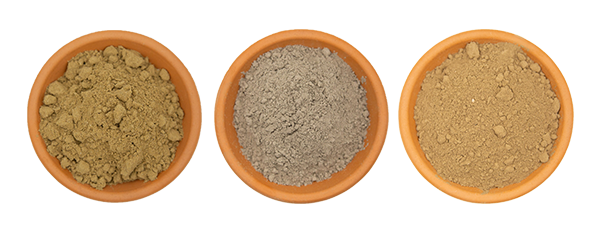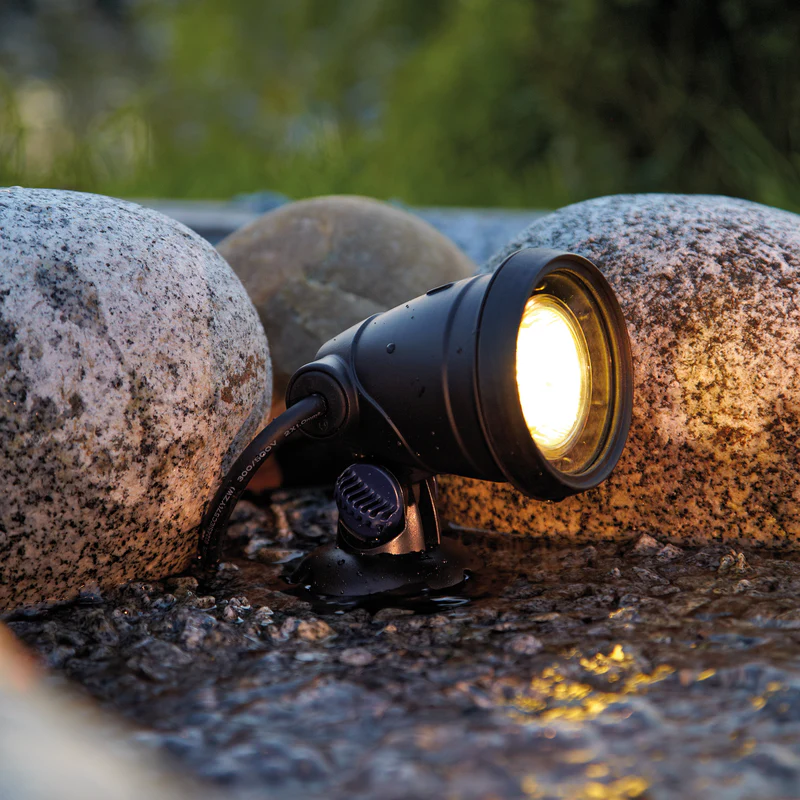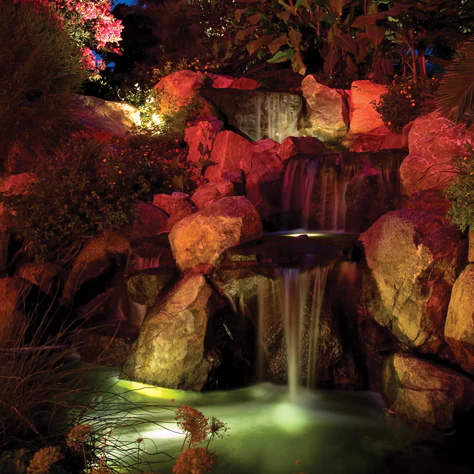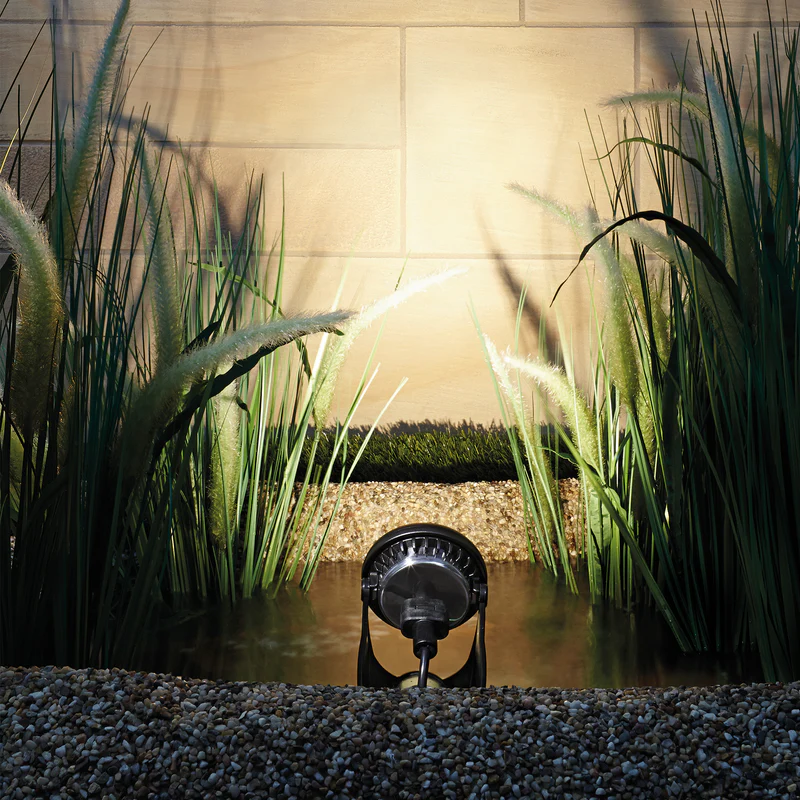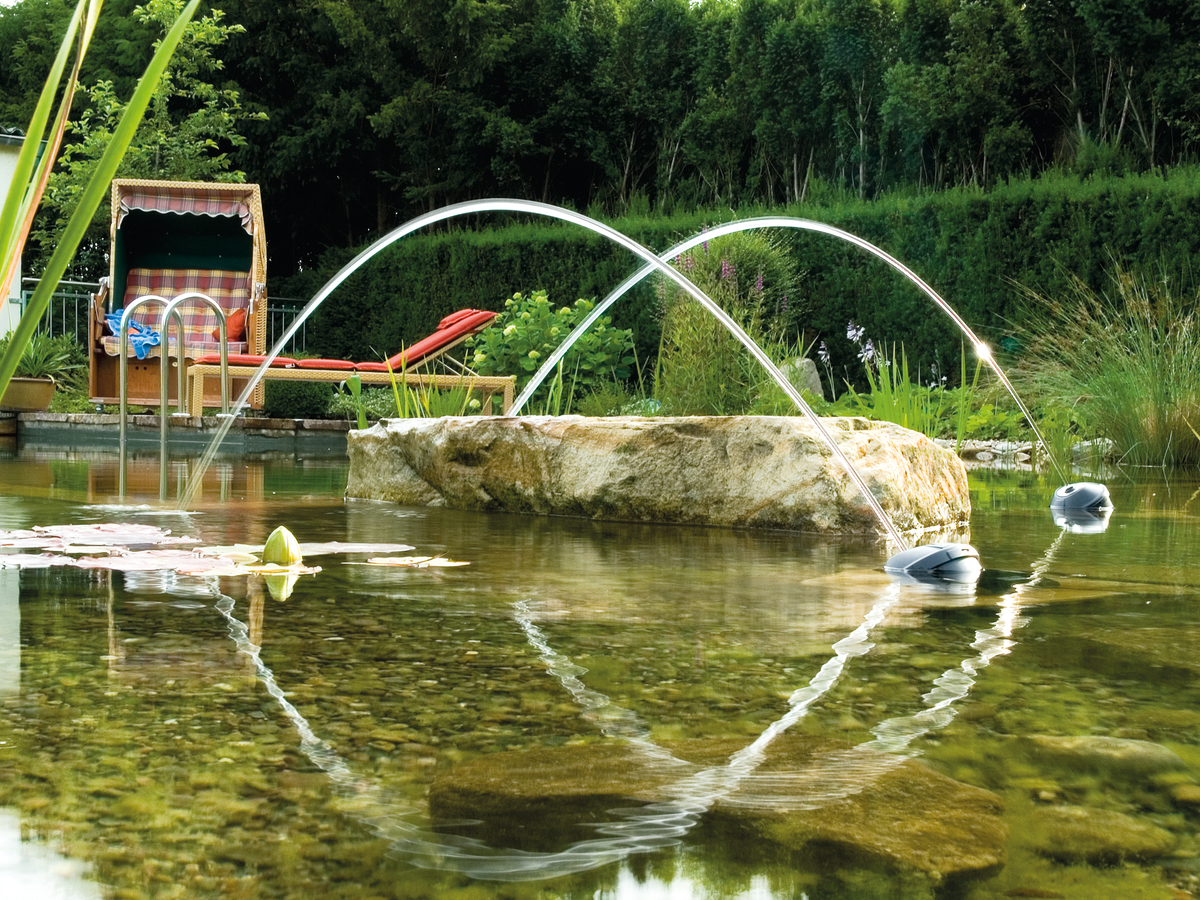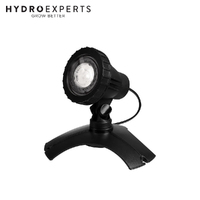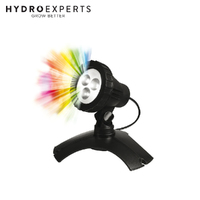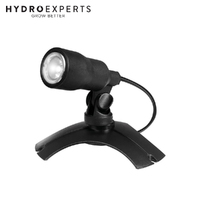Dramatise Your Pond with Lighting: Tips and Techniques
By Hydro Experts | 15 July 2025

A well-lit pond can completely change the look of your garden once the sun sets. With the right lighting, your water feature can sparkle at night, highlight key elements like waterfalls or fish, and even make your outdoor space safer.
Whether you're looking to create a peaceful retreat or just a safe space, pond lighting is an easy and rewarding upgrade. In this guide, we'll highlight some of the best lighting options, how to choose the right setup, and simple tips to make your pond glow beautifully after dark. So, let's get started.
Why Add Lighting to Your Pond?
Adding lighting to your pond comes with more benefits than just aesthetics. From improving overall safety to boosting visual, there are many reasons to add lighting to your pond.
- Creates Stunning Ambiance: Soft, shimmering lights reflect off the water and automatically add an extra touch to your pond's natural beauty. This also makes a peaceful, magical retreat, perfect for evening relaxation or entertaining.
- Make Things Stand Out: When the light is added at a perfect angle, it draws attention to your favorite elements, whether it's a waterfall, vibrant fish, or unique aquatic plants.
- Extends Enjoyment: Why limit your pond's beauty to just daylight hours? Proper lighting allows you to appreciate its charm and tranquility well into the evening.
- Improves Safety: Properly placed lights around your pond can illuminate walkways, preventing trips and falls, making your garden safer for everyone.
- Boosts Property Value: A well-designed, lit pond adds a touch of luxury to your landscape, which is more likely to increase your home's appeal.
Types of Pond Lighting Options
Choosing the right lights is key to achieving your desired effect. When it comes to the option, there are many. So, to make things easy for you, here are some different types of pond lighting options you can go for:
1. Underwater Lights
Underwater lights are fully submerged in the water, creating a magical glow from within the pond itself. They're excellent for illuminating fish, water movement, or specific underwater features. Brands like PondMAX and OASE offer a wide range of durable and effective underwater LED lights, perfect for creating that mesmerizing internal glow. With this light for your pond, you are sure to get the effect you are looking for.
Pros
- Creates a dramatic effect
- Can highlight water clarity and fish colors
- Perfect option for waterfalls
Cons
- Can sometimes be affected by algae or debris
- Requires a waterproof installation
2. Above-Water Lights
Placed around the perimeter of your pond, these lights illuminate surrounding plants, rocks, or pathways, creating a layered lighting effect in your garden.
Pros
- Versatile for lighting the landscape around the pond
- Safer to install as they aren't submerged
Cons
- Can create glare if not positioned carefully
- Doesn't directly illuminate underwater features
3. Floating Lights
These decorative lights float on the water's surface, casting soft reflections and adding an aesthetic touch. They are often solar-powered and can come in various shapes. OASE offers advanced floating fountain illumination sets that integrate LED lights to dramatic effect.
Pros
- Easy to deploy
- No wiring needed if solar
Cons
- Can drift with currents
- Often depends on sun exposure for solar models
4. Waterfall and Fountain Lights
Specifically designed to enhance the beauty of moving water, these lights are often integrated into pumps or placed directly under a water flow to make it sparkle.
Pros
- Dramatizes water features
- Highlights movement and sound
Cons
- Specific placement required
- May need professional installation for integrated systems
Factors to Consider When Choosing the Right Pond Lighting
To be frank, not all pond lighting comes with the same features; some are just bound to stand out than others. So, here are certain factors to consider when choosing the right pond lighting:
1. Power Source: Solar vs. Low-Voltage
Choosing how your lights get power is one of the first decisions you'll need to make. Each option has its own benefits and drawbacks depending on your setup.
Solar-powered lights are fantastic for their ease of installation since they don't require any wiring to your home's electricity. In addition, they also collect energy from the sun during the day and automatically turn on at dusk. This makes them perfect for remote areas of your garden where running wires would be difficult. However, their brightness and how long they stay lit depend entirely on how much sunlight they get, so they might not be as consistent or bright as wired options.
Low-voltage lighting systems are very popular for ponds because they're safe, reliable, and energy-efficient. They use a transformer to convert your household's standard electricity to a much lower, safer voltage. While they require some wiring, it's generally safe and straightforward for DIY enthusiasts.
2. Brightness and Color Temperature
The brightness and hue of your lights play a huge role in the final look and feel of your pond. Understanding these terms will help you pick the right ones.
Brightness, measured in lumens, tells you how much light a bulb puts out. A higher lumen number means a brighter light. For a subtle, gentle glow, you might choose lights with fewer lumens, while a dramatic spotlight on a waterfall would require more lumens. Think about what you want to highlight and how much light you need for that effect.
Color temperature, measured in Kelvin (K), describes the "warmth" or "coolness" of the light. Warm white light (around 2700K-3000K) has a cozy, inviting glow similar to traditional bulbs or candlelight. Cool white light (4000K and above) is brighter and more modern, sometimes with a slight blue tint, great for a crisp, clear look. Some lights also offer RGB (Red-Green-Blue) options, allowing you to change colors for different moods or holidays.
3. Durability and Waterproofing
Since your lights will be near or in water, their ability to withstand the elements is critical for safety and longevity. This is where the IP rating comes in.
The IP (Ingress Protection) rating is a two-digit number. The first digit indicates protection against solids (like dust), and the second digit indicates protection against liquids (like water). For submersible pond lights, you'll want a very high water protection rating, ideally IP67 or IP68. An IP67 rating means the light is protected against temporary immersion in water, while an IP68 rating means it can be continuously submerged.
Choosing lights with a high IP rating ensures they are completely sealed against water intrusion, preventing damage to the electrical components and ensuring they operate safely. This also means they'll last longer, giving you more enjoyment from your investment. Always check the IP rating, especially for any lights you plan to put in the water.
4. Energy Efficiency
Going for energy-efficient lighting not only saves you money on your electricity bill but also helps the environment.
LED (Light Emitting Diode) lights are by far the most energy-efficient choice for pond lighting. They consume significantly less power than older halogen or incandescent bulbs and have a much longer lifespan, often lasting tens of thousands of hours. This means fewer bulb replacements and lower operating costs over time.
While the initial cost of LED lights might be slightly higher, the long-term savings in energy consumption and maintenance make them a smart investment for any pond owner. They also produce less heat, which is a benefit for the pond's ecosystem.
5. Installation Complexity
Consider how easy the lights are to set up, especially if you plan to do it yourself. Solar lights are the easiest to install as they generally just need to be placed in a sunny spot and sometimes have a stake to push into the ground. There's no wiring involved, making them ideal for quick setups or temporary displays.
Low-voltage systems involve running wires from a transformer to each light fixture. While it's a manageable DIY project for many, it requires careful planning to hide wires and ensure waterproof connections. If you're not comfortable with basic electrical work, you might consider hiring a professional. High-voltage lights (standard household voltage) are rarely used directly in or near ponds for safety reasons and should always be installed by a licensed electrician.
Tips & Techniques to Maximise Lighting
Here are some extra tips and techniques to maximise lighting for your pond:
1. Layer Your Lighting
Combine different light types like submersible, spotlight, and border lights for a rich, layered effect. This approach creates depth and avoids flat or dull lighting. It's a great way to highlight various textures and water movement.
2. Focus on Focal Points
Use lighting to draw attention to specific pond elements, like waterfalls, fountains, or statues. Focal lighting adds drama and guides the viewer's eye. It's an easy way to showcase your pond's best features.
3. Play with Reflections
Strategically position lights to bounce off the water's surface and nearby rocks or plants. Reflections can double the impact of each light and create a soothing, mirror-like effect on calm water.
4. Use Colored Lighting
RGB or color-changing lights can set the mood, but use them carefully to avoid overwhelming the scene. Try using soft blues or greens for a natural feel, or change colors seasonally to keep things interesting. PondMAX offers remote-controlled color-changing LED kits, allowing for easy adjustment.
5. Avoid Light Pollution
Point lights downward or inward to avoid shining into your neighbor's yard or your own windows. Proper placement keeps the pond as the focus and preserves a peaceful outdoor setting.
Installation Tips and Safety Considerations
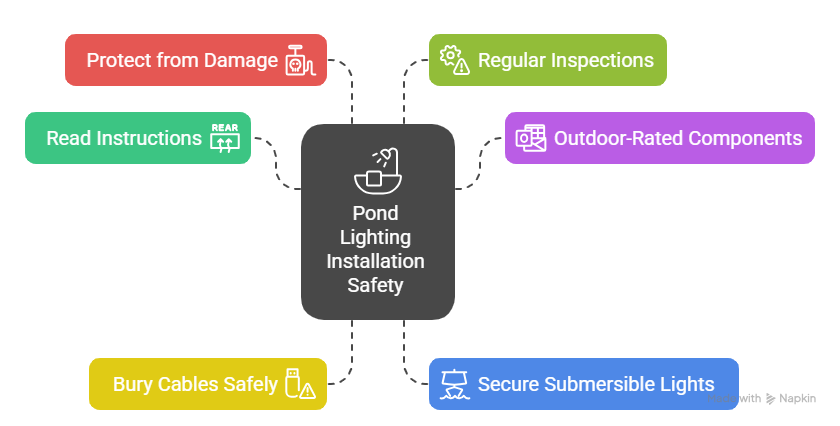
Installing pond lighting can be a rewarding DIY project, but safety should always be your top priority. If you're ever unsure about electrical work, it's best to hire a licensed electrician.
- Read All Instructions: Always thoroughly read and follow the manufacturer's installation guide for every light fixture and transformer.
- Use Outdoor-Rated Components: Ensure all lights, cables, and transformers are specifically designed and rated for outdoor and wet environments. Look for the appropriate IP ratings. PondMAX and OASE products are typically built to these standards.
- Bury Cables Safely: For low-voltage systems, bury cables at a safe depth (check local codes, typically 6-12 inches) to prevent tripping hazards and damage from gardening tools or pets. Use waterproof connectors for all cable splices.
- Secure Submersible Lights: Ensure any lights placed underwater are securely anchored with weights or mounts so they don't float away or shift from your desired position.
- Protect from Damage: Route cables away from areas prone to heavy foot traffic, sharp objects, or animal activity. Consider using PVC conduit for extra protection in vulnerable areas.
- Regular Inspections: Periodically check all wires, connections, and light fixtures for any signs of wear, fraying, or damage, especially after severe weather.
Common Pond Lighting Issues and Their Solutions
Even with careful installation, you might run into some common pond lighting problems. Here's how to troubleshoot them:
Lights Not Turning On
Problem: Your lights are completely dark.
Solution: First, check if the transformer is plugged into a working outlet and if its power switch is on. See if the GFCI outlet has tripped (it might have a reset button). Inspect all connections for looseness or corrosion. If it's a solar light, ensure the solar panel is clean and getting direct sunlight. Finally, test individual bulbs or LED units if possible.
Lights Are Dim or Flickering
Problem: The lights are not as bright as they should be, or they constantly flash on and off.
Solution: This is often due to a voltage drop in low-voltage systems. This can happen if your wires are too long, too thin for the total wattage of your lights, or if your transformer is too small for the load. Ensure your transformer is appropriately sized. Check all connections for corrosion or looseness, which can impede power flow. For solar lights, inadequate sunlight or a dirty solar panel can cause dimness.
Algae Growth on Underwater Lights
Problem: A green, slimy film covers your submersible lights, dulling their glow and making them less effective.
Solution: Regularly clean the lenses of your underwater lights with a soft brush or cloth to remove any algae or mineral deposits. This is a normal part of pond maintenance. You might also want to review your pond's overall algae control strategy to reduce growth in general.
Water Inside Light Fixtures
Problem: You notice condensation or actual water pooling inside the clear housing of your light fixtures.
Solution: This indicates that the waterproof seal on the fixture has been compromised. Immediately unplug the system to prevent electrical hazards. The fixture is no longer safe or functional and should be replaced with a new, fully waterproof unit (check its IP rating carefully).
Cables or Wires Are Damaged
Problem: You find signs of wires being chewed by animals, cut by gardening tools, or otherwise exposed.
Solution: Immediately unplug the entire lighting system to prevent an electric shock. Carefully inspect the damaged section. For minor damage, you might be able to repair it using a waterproof splicing kit specifically designed for outdoor electrical wires. For significant damage, it's safer to replace the entire cable section or consult an electrician. Burying cables deeper or enclosing them in protective conduit can help prevent future damage.
Conclusion
Adding lighting to your pond is a fantastic way to enhance your outdoor living space, transforming it into a captivating focal point that can be enjoyed both day and night. By understanding the different types of lights, planning your design carefully, considering safety during installation, and knowing how to troubleshoot common issues, you can create a truly magical and inviting water feature.
Ready to see your pond in a whole new light? Which lighting technique are you most excited to try first to dramatize your pond?
FAQs
The best lighting for ponds depends on your goal. Submersible LED lights, such as those offered by PondMAX and OASE, are ideal for an underwater glow, while spotlights and pathway lights help highlight features and improve safety. For energy savings, solar-powered lights are a great choice, though they may not be as bright as wired systems.
Yes, pond lighting is generally safe for fish and plants, especially when using low-voltage, LED, or waterproof lights. Avoid placing lights too close to sensitive aquatic life and choose products rated for underwater use (IP68) to prevent electrical hazards.
The number of pond lights needed depends on pond size, depth, and the effect you want. A small pond may need just 2–3 lights for accenting, while larger ponds with waterfalls or multiple features might need 5–8 lights or more for full coverage.
Yes, many low-voltage and solar pond lighting kits are designed for DIY installation. Both PondMAX and OASE offer user-friendly kits. However, if you plan to use mains-powered lighting, it's recommended to hire a licensed electrician to ensure safe and proper installation around water.
To keep pond lights in top condition, clean the lenses regularly to remove algae and dirt, check for water leaks in the casing, and replace any weak or flickering bulbs. For solar lights, make sure they receive enough direct sunlight during the day.

